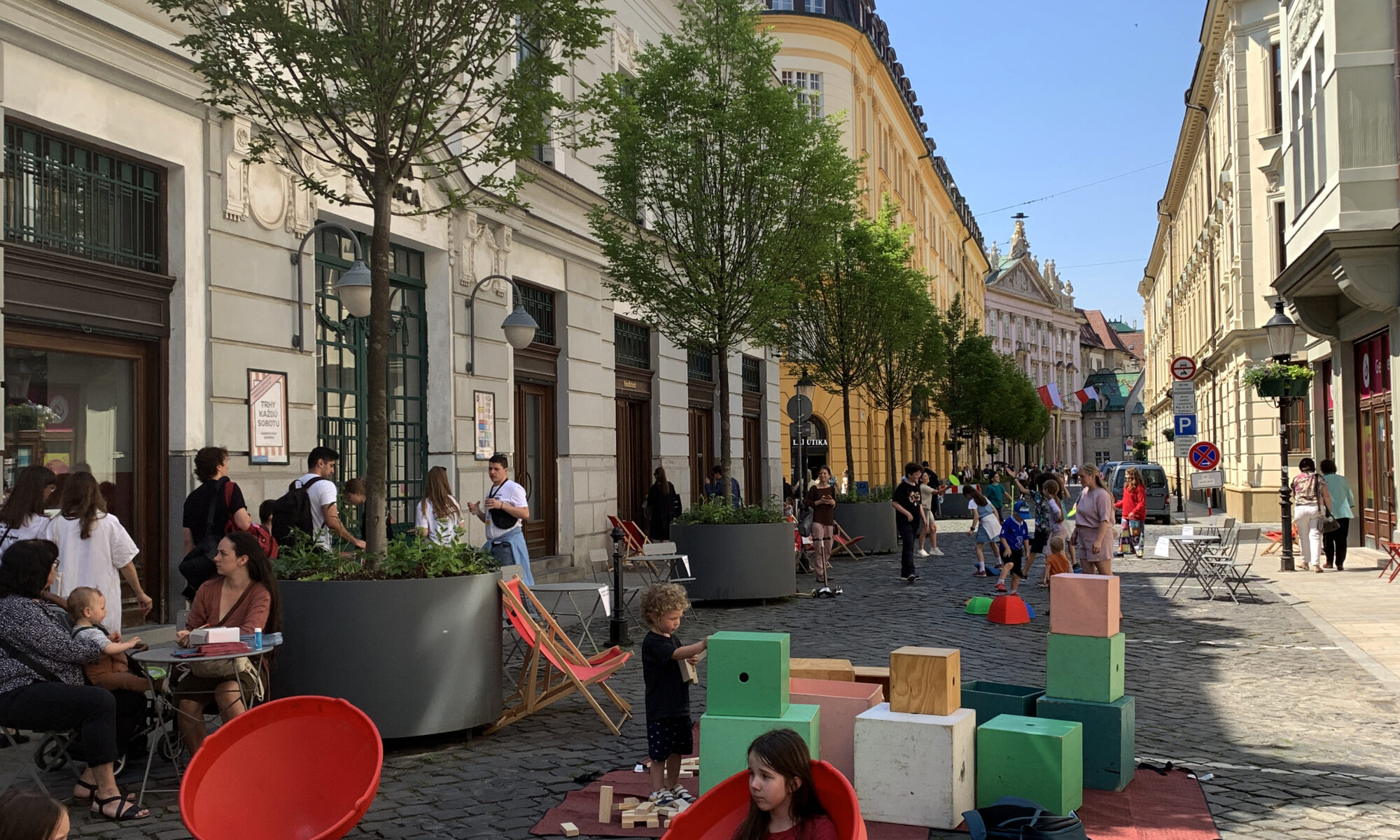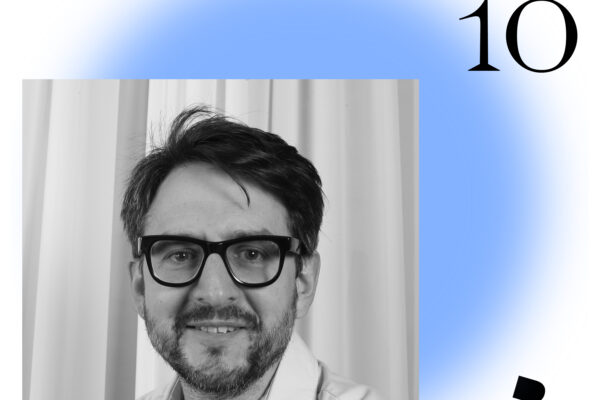The Start with Children – Bratislava Summit (28-29 May 2024) was a dynamic event focused on integrating children’s perspectives into urban planning and community development. Päivi Raivio, co-founder and founding partner of RaivioBumann & Parkly attended the summit and summed up some of the conference highlights in this article, which also features a short interview with Gil Penalosa.

The Start with Children – Bratislava Summit was organised by the City of Bratislava and the Metropolitan Institute of Bratislava – and it was the first of its kind. As many pioneers of child-friendly city planning, such as Tim Gill, have pointed out, they have been waiting for such a conference for over 20 years – it was a landmark event for those who have been working in the field for decades. The conference signified that child-friendly city planning is finally being brought to the forefront of urban planning and highlighted that this approach can be a crucial tool in advancing all aspects of livable cities:
Petra Marko, the Chief Executive of Metropolitan Institute of Bratislava, sums up the summit’s mission: “Start with Children summit created the first major platform where city leaders and experts from around the world shared their know-how on child-friendly cities and why it could become a game changer when it comes to tackling future challenges. Children have been consistently designed out of city environments over the course of the 20th Century as roads became wider, distances vast and city spaces became increasingly overtaken by cars. The summit showed how cities facing seemingly insurmountable challenges were able to transform when vision and political leadership prioritised what is right through the lens of the most vulnerable – children. From tackling air pollution through to creating equitable public spaces, city greening, advancing cycling and walking or integrating play into city planning.”
The summit featured high-profile speakers from around the globe, including Jan Gehl, Ankita Chacra, Amanda M. Burden, Tim Gill, Xoli Fuyani, and more. I had the chance to sit down with one of them, Gil Penalosa, the founder of 8-80 Cities, to discuss his vision and expert advice on city planning for all ages.
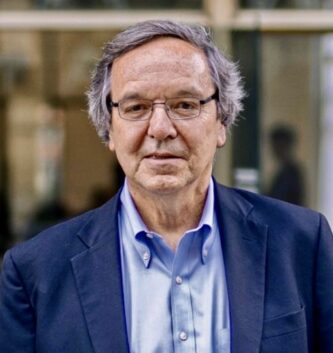
Gil Penalosa, in your keynote you talked about the CAVE people (citizens against virtually everything). It was funny, but also, as many of us know, very true. What is the best way to break through the loud minority cycle of opposition? After all, it is very much also about creating room for the silent, which children often are when it comes to participation and democracy.
“We need people to address the issue of the loud minority receiving disproportionate media coverage. It’s problematic when, for example, three people opposing a safer road are given significant space in local media and are referred to as the “community.” Three people do not represent the entire community. To counteract this, citizens need to show up and express their opinions through their presence. Many don’t realize the power they hold if they simply make themselves visible.
Public meetings can also be problematic, as those who oppose something strongly are usually the ones who participate, leaving the majority unheard and invisible. I urge citizens to show up and support positive changes in their city or demand that their leaders do more for a child-friendly, safer city. This is not a time to be silent: email your councilors, email your city staff, and attend public meetings.
Secondly, those driving or planning these changes need to focus more on communicating the benefits: it’s not just about the new sidewalk or park. The emphasis should be on the broader advantages these changes bring to the community. These benefits might include economic development, environmental improvements, mental and physical health enhancements, and much more. For instance, in Paris, numerous school streets are being created by closing the streets in front of schools and planting trees. This initiative doesn’t just benefit the school; the entire district enjoys cleaner air, less traffic, more urban green space, improved safety, and other advantages. The new sidewalk, bike lane, or parkway is a means to achieve these benefits for the entire community, and potentially the entire city.
Throughout the summit, we have heard keynotes highlighting that one of the biggest, if not the biggest, obstacles to creating child-friendly cities is the dominance of cars. This issue is evident in Helsinki as well: while we have ample green spaces, good city connectivity, and children who are active outdoors and fairly independent, the infrastructure catering to cars—such as roads, parking spaces, and street speed limits—remains a significant barrier. This topic is highly debated politically, and progress toward change is often slow. How to change the course of car dominance in cities? The argument for “balance” often favoring cars is a common refrain.
“I agree – and for those calling for “balance”, I would say: first, let’s have equality. You cannot have balance if you are running a 100 meter race, with some people starting at the 90 meters and some people are the 0. So just to have balance is not okay, you need equity – you need people to start at the same place. And then you can have equality.
When you have built the city in the last 80 years around the car one cannot say “we need balance”. We need to ensure that our cities are balanced towards pedestrians and the children. Again, we should focus on the benefits and the effects of slower cities: we know that if there are fewer cars, people walk more. When the cars drive fast, people don’t like to walk along the same roads, but when the cars drive 30 km/h – it’s already a pleasant surrounding to walk in. I strongly think that all of the streets should be within 30 km/h, except the bigger ones, and this should be enforced with speed bumps or cameras. If you are serious about creating a city for children you need to slow down the cars and also to restrict the size of the cars, such as SUVS, or restrict them with a permit.”
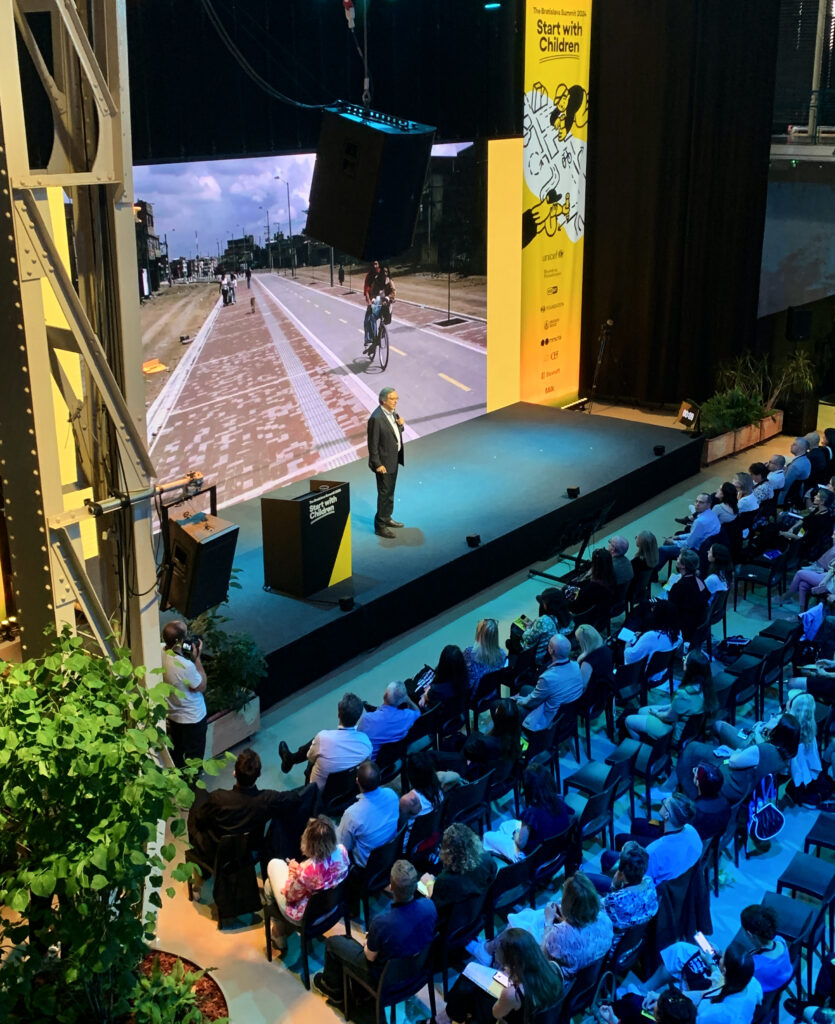
Since starting the 8 – 80 city concept, what has changed the most? Are you hopeful for the future?
“I am very hopeful because I think that we are paying more and more attention to children. My analogue of football: 20 years ago we were not even on the field. We were playing in the park. Now we are on the field and everybody’s talking about it. But we’re not scoring the goals yet, we need to do more. Many cities are talking about child friendliness, but not doing enough. And, as the concept 8-80 refers to, we need to focus on the elderly too: it’s one third of our lives – and we are living much longer. We have added years to our lives, but we have not added life to those years – and implement programmes, activities, active places, opportunities to socialize and be active. That’s why these two groups are highlighted in the 8-80 concept: creating better cities, better lives for children – and the elderly, benefits all.”
Finally, a question about participation. How can we ensure that children are part of the planning processes? How can we amplify the voices of children and others who are not attending council meetings?
“Unfortunately, there’s a lot of “tokenism” around: city planners and decision makers often aren’t genuinely interested in true community participation. The first thing is that they must honestly want to listen to the citizens. Secondly, we need to ensure that everyone is heard. For example, if we’re designing new parks, we need to listen to children and all other age groups and segments of the community. This isn’t happening at public meetings dominated by the CAVE (Citizens Against Virtually Everything) people. Maybe we need to rethink the place and time of these meetings—perhaps city hall at 7 PM isn’t ideal. Maybe it’s the communication method that needs to change. For example, we could hold public meetings in the park during the daytime.
Thirdly, we should start at the very beginning: when you first engage with the community, go with a blank page, not with designs that are already fully finished. You need to ask for input and formulate ideas together with the community. It starts with listening. After determining the “what” together, then in the second phase, you invite the experts—the planners, the architects, etc. These experts can then translate the community’s ideas, wishes, and needs into a feasible plan. There should be iterations with drafts: is this what we heard? Are we moving in the right direction? The discussion should remain open, with the community being the experts on the “what” and cities should invest into defining the “what” with the community. It’s not possible to always have 100% based on the community’s ideas, and it’s not possible to please everyone, but you should aim that at least 80% of the plan is based on the community’s wishes and needs.”
“If you are not starting with children – if you are not talking about – and thinking about – them in your plans and programmes – then you are not only cheating children out of a happy, healthy childhood. You are also missing out on the best way to set cities on a firm course towards becoming healthier, greener, more inclusive places.”
Tim Gill, Independent Scholar, Writer and Consultant
In addition to the keynotes and presentations, the summit featured workshops and interactive sessions, serving as a crucial platform for exchanging insights and best practices aimed at fostering more child-friendly environments. I took part in the workshop led by Sophia Schuff and Sandra Al Richani from Gehl Architects. It was a pleasure to exchange knowledge, share ideas and tackle a universal challenge together and work on ideas for a more child-friendly suburban area – in our group, located in Budapest.
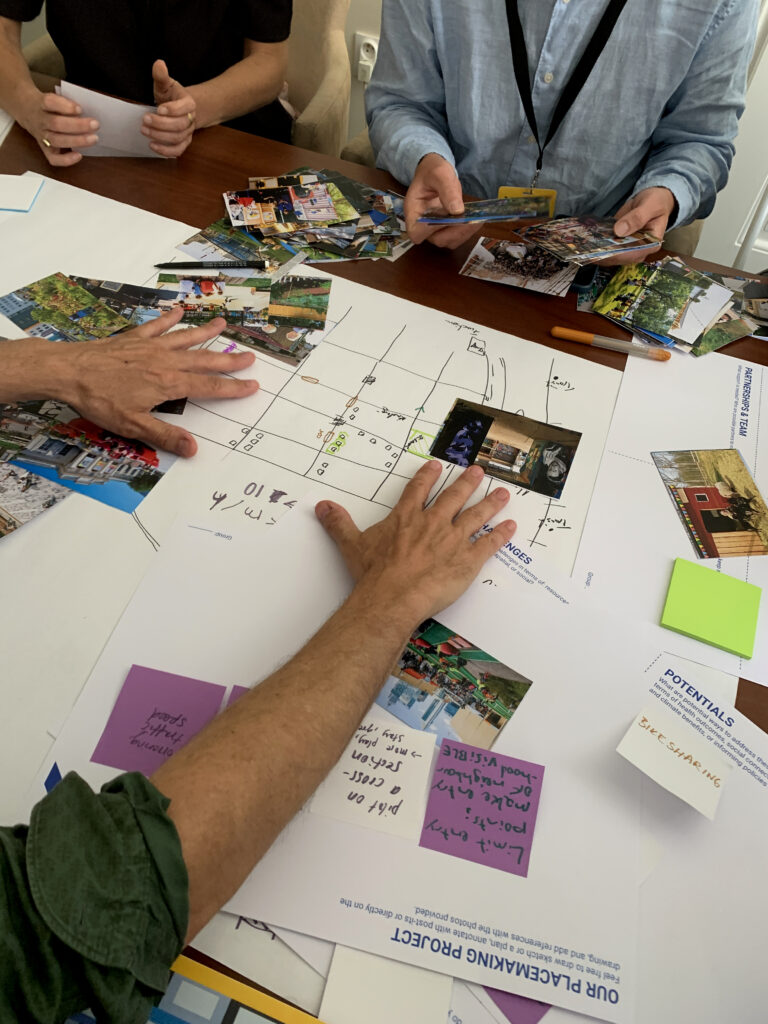
Additionally, outside the venue, a play street dynamically brought these topics to life. Children of all ages engaged in creative activities, games, and sports equipment, vividly showcasing the potential transformation of any appropriately sized street in any city into a vibrant community space. This demonstration underscored the tangible benefits of reimagining urban spaces to prioritise children’s well-being and play.
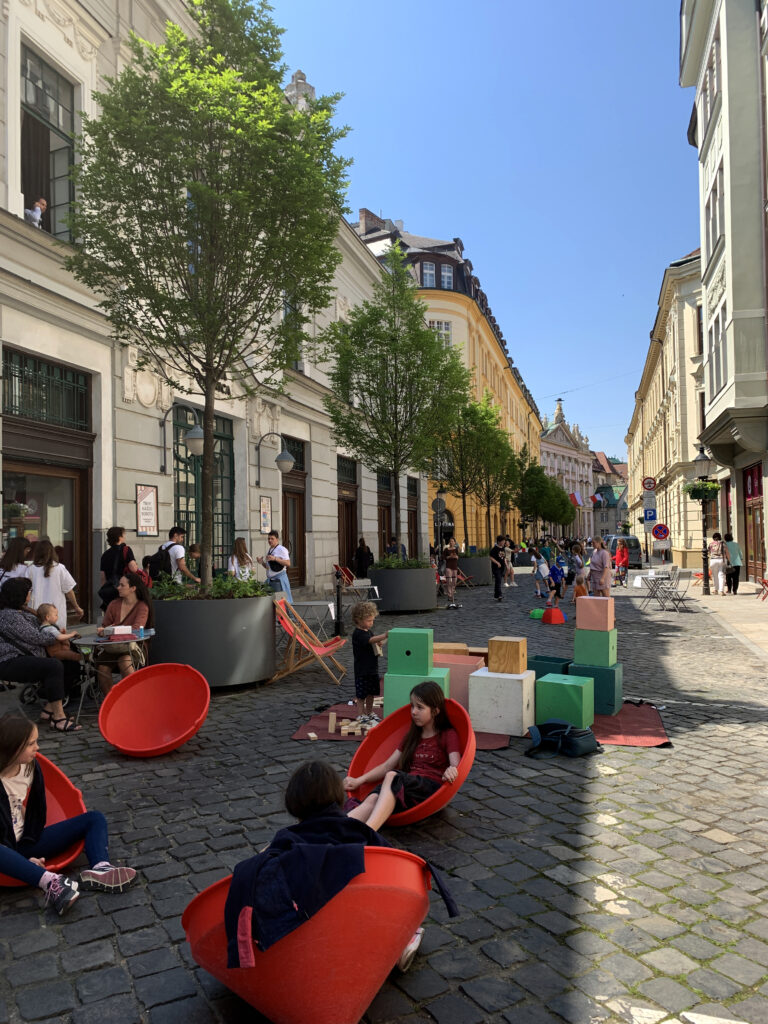
Personal key takeaways from the summit:
Impressed about how committed – and outspoken – the mayors Erion Veliaj (Tirana) Matúš Vallo (Bratislava) and other mayors who presented in the summit were about creating less car centric cities and more child friendly cities. For instance, Bratislava aims to become the best city for children, while Tirana has persevered through protests to realize their vision. Their efforts have resulted in some of the most beloved, secure, and family-friendly public spaces, like big playful parks and a transition from a car-centric square into a square for all.
Inspired by all the great examples of child friendly public places around the globe – on how the commitment pays off and the approach can be applied on different levels of urban planning, like the neighbourhood in Vauban, Freiburg in Germany – introduced by Tim Gill to street corners, play parks and traffic plans.
Moved by the speakers whose perspectives were transformed by children—whether their own, nephews, neighbours—to perceive the city through children’s eyes, value unstructured play, tackle traffic challenges, dedicated to combating the climate crisis and advocate for the 30% of the population absent from committees, public hearings, and online surveys, yet representing 100% of our future, as Gil Penalosa emphasised. Children are more susceptible to heat stress, as Ankita Chacra pointed out, which highlights the importance of including this perspective in adult-driven data collection and planning.
Committed to integrating child-friendly aspects more deeply into our work within child friendly urban design and placemaking initiatives, whether through implementing traffic strategies, enhancing play opportunities, accessibility or fostering self-expression. We gained more knowledge on how to emphasise the importance of collecting data for our collaborators, clients, and decision-makers to ensure knowledge sharing and the integration of child-friendly urban design and placemaking strategies.
Rockstar-moment I was thrilled to witness Jan Gehl’s keynote live – after all, his book “Life Between Buildings” played a pivotal role in steering me from product design towards human-centered approach in designing public spaces and fostering participation in shared environments. His poignant presentations captured challenges our cities face: keep us apart from others, empty places or uninviting streets. Gehl critiqued the modernist perspective of cities as machines, emphasising that “the city may be one, but people are not.” And it’s the emotional, instinctive, and social side of ours, which needs to be designed for as much, or if not more, as the functional side. He also pointed out how data is used – and misused in city planning. It can actually reveal our values, perhaps more obviously than anything else: “You count what you care for”.
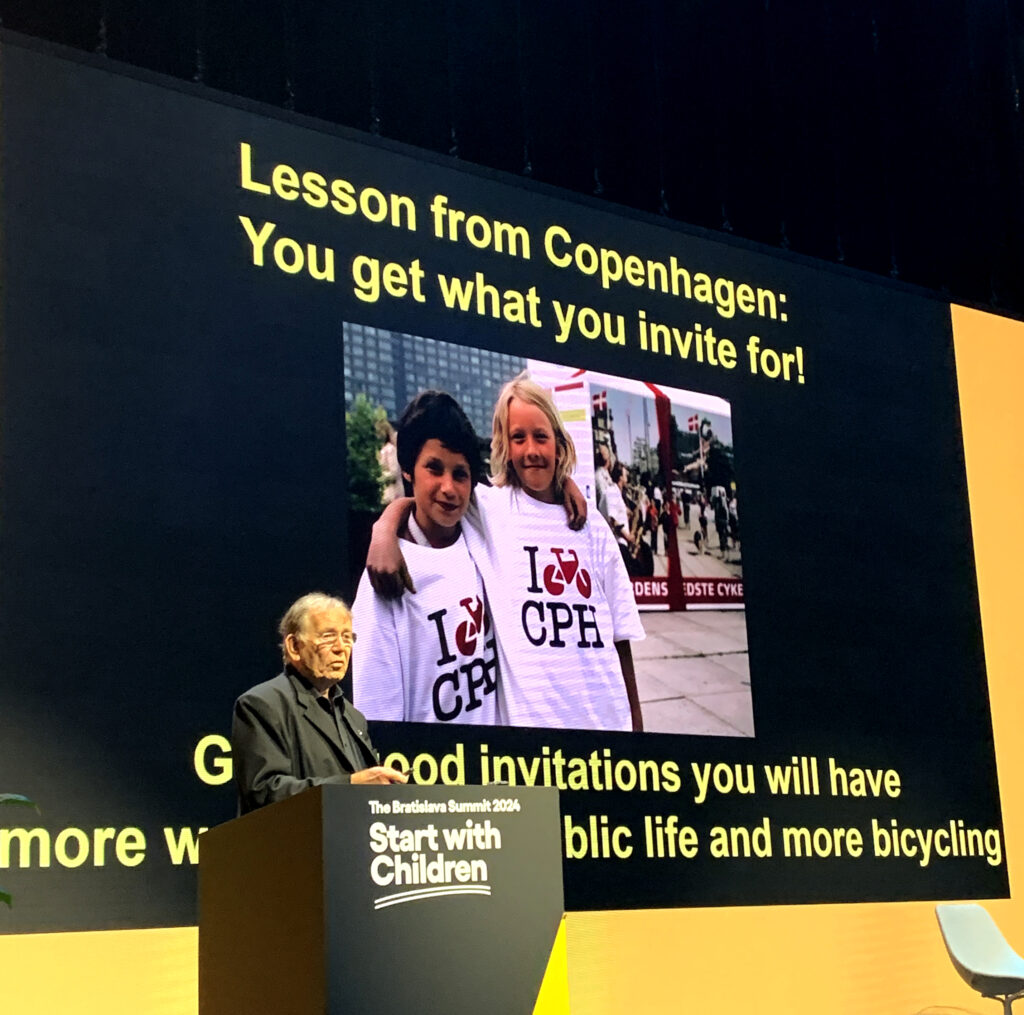
“When we are together, we go further, faster.”
Matúš Vallo, Mayor of Bratislava
The summit is a beginning for a wider collaboration across cities – and the summit marks the establishment of new networks for city leaders committed to child friendly cities:
“The summit opened this discussion and sharing of know-how, but its bigger goal is to also ignite collaboration and action on the ground. That’s why a Mayor’s Alliance for Children was launched at this first summit. The alliance will establish a network of European city leaders, aligning the interests of cities and funders to support child- and family-centered climate adaptation projects and initiatives.” says Petra Marko.
The conference, through its network and alliances, continues, in between events, to frame urban planning in a new way: “We need a better frame than the one we’ve been using, and that new frame is children and families.” Simon Battisti, Creative Director, Start with Children.
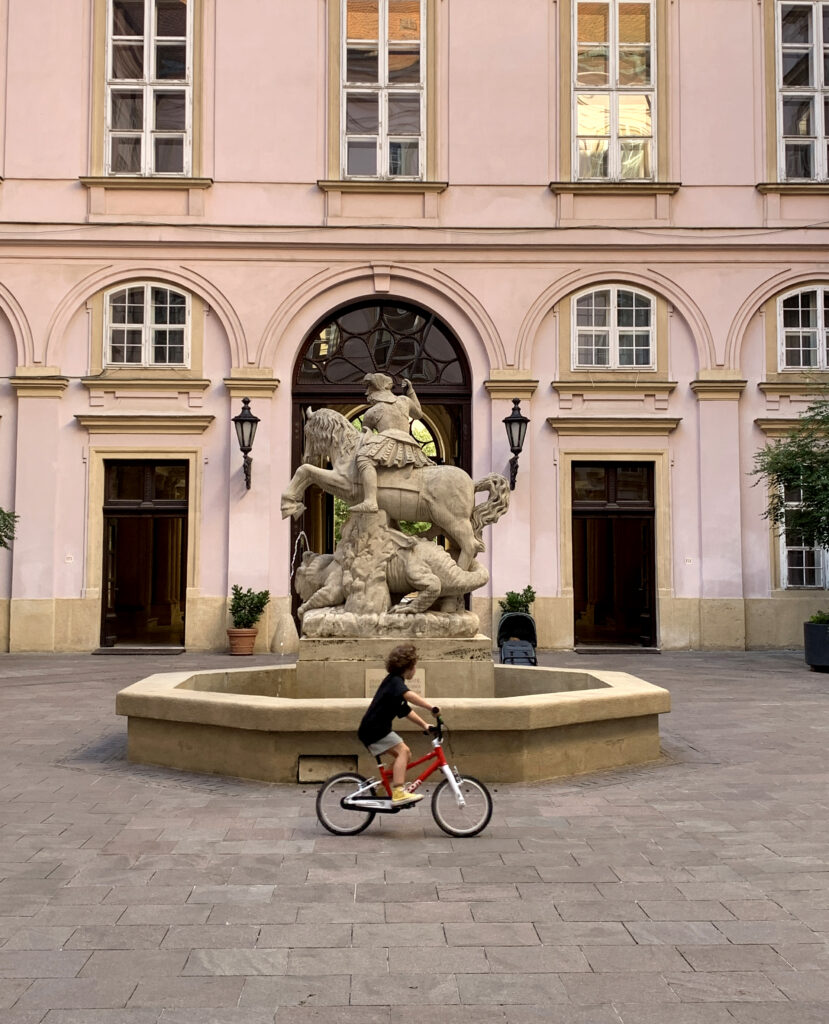
Photos & article: Päivi Raivio

